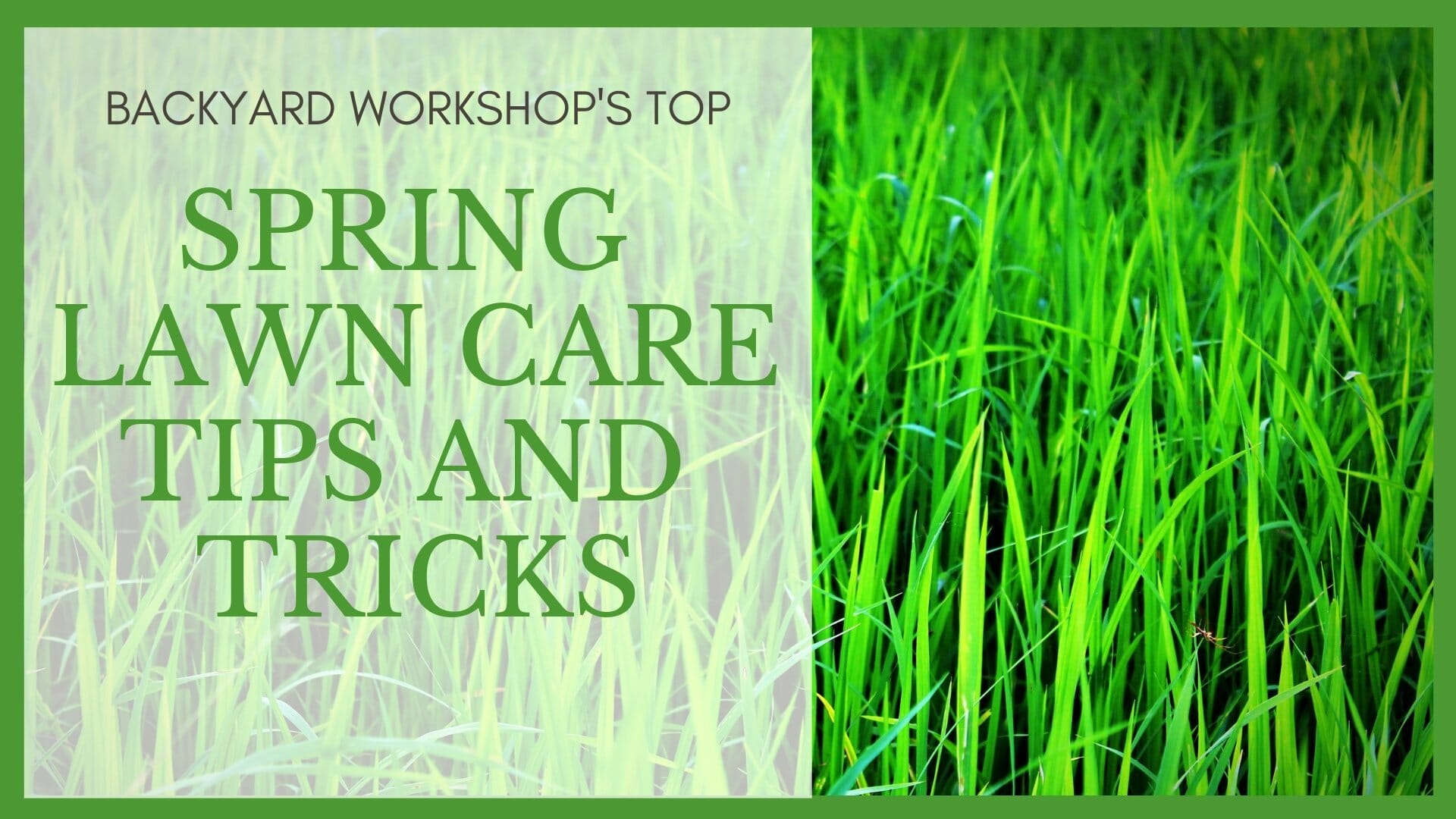Spring Lawn Care Tips and Tricks

Spring is the season for budding, growing and new life and you’re eager to be outside and in the garden. Be patient; if you start too soon with heavy-duty lawn care, you may damage the new tender shoots.
In this article, we address the basic questions you should ask yourself before starting with lawn care or purchasing fertilizer, pesticides and other items you’ll need. To know what your grass needs, you should take into account the variety of grass, consider the climate, and the state of your lawn. Maybe your yard doesn’t need fertilizer – or perhaps it needs it often. Is fertilizer the only Spring grass care necessary for a lush green lawn?
What Variety of Grass Do You Have?
If you live in the southern part of the country, it’s likely that the variety of grass you have is a warm-season grass. Warm-season grass grows best during Spring and Summer, from April to October. Bermudagrass, Buffalo grass, Zoysia grass, and St Augustine grass are warm-season grass varieties.
In the northern part of the country, you’ll find the cool-season grasses like Kentucky bluegrass, Annual Ryegrass, Perennial Ryegrass, and Creeping Red Fescue. It’s best growth time is late Spring and early Fall.
Both, cool-season kind of grass and warm-season grasses, grow in the transitional zone, the region between the northern and southern parts of the country.
What About Leaves and Aeration?
Why should you rake leaves in Spring if you’ve already collected leaves during the Fall season?
In snow areas, pink snow mold and gray snow mold may occur. When snow comes before the ground has frozen, it provides an ideal fungal breeding environment during the winter months. Raking removes mold patches. Alternatively, you can wait a few weeks. The warmer weather may dry up the mold patches.
When cleaning driveways, spread the snow evenly to melt quicker. Large snow piles may prolong the moisture holding process and stimulating the snow mold fungal growth.
Controlling thatch build-up is another motivator for leave raking. Excessive thatch may be the reason why the grassroots system isn’t receiving the nutrients, sunlight, and water it needs for early Spring growth.
If soil compaction was so dense that aeration during Fall didn’t solve the issue, then repeat aeration during Spring so that air and nutrients can reach the soil and penetrated the roots. Usually, aeration isn’t necessary during the Spring months.
How To Prevent Weeds on Your Lawn?
Getting rid of weeds is always part of lawn maintenance, irrespective of the season. Smart Spring lawn care prevents weed sprouting and therefore decreases the necessity of weed control during the Summer and Fall.
Have you noticed there are certain spots on your lawn that always grow weeds? Use pre-emergent herbicides on these areas. It prevents seed germination and will stop future growth of weeds like crabgrass.
Pre-emergent herbicides work well on all lawns, irrespective of the type of grass. Re-apply after about 12 weeks.
If you choose to use herbicides, then you’ll have to wait till next Spring to plant new grass. Unfortunately, pre-emergent herbicides don’t limit its effectiveness to weeds only but will prevent grass sprouting too.
When Do I Plant and Reseed Grass?
Spring is the season for seeding and planting.
Plant warm-season grasses toward the end of Spring and early Summer. There shouldn’t be any inclination of frost, and the soil temperate should be in the 60s.
Wait until the soil temperature is in the 50s before planting cool-season grasses. Plant early enough to give the grass seedlings time to establish so it can withstand the heat of summer.
Before planting grass, make sure the soil is fertile enough. Soil quality may be the reason the grass doesn’t grow in certain areas of the lawn. A soil test determines what the soil lacks. Grass requires alkaline soil. Add lime to the earth if the pH is below 6 indicating acidic soil. For maximum effect, wait about three weeks before fertilizing the lawn.
Should I Use Fertilizer? If so, What Type?
Applying fertilizer early Spring is not always the best option. Before stimulating grass leaf growth, the root system needs to complete its growth process. Strong roots help the grass survive the Winter months. If you fertilized late Fall, there should be enough nutrients in the soil for the initial Spring growth.
Wait until the last frost to fertilize warm-season grass. By then the roots are strong, and the leaves need nutrients for growth.
Cool-season grasses, however, won’t survive the hot Summer with too much growth stimulation during Spring. Use slow-release fertilizers if you need to fertilize in Spring. Most organic fertilizers are slow-releasing fertilizers like compost or mulch formed with mulching lawn mowers.
Overfertilizing will damage the grass and stimulate additional weed growth. With excess fertilizer, the phosphorus isn’t utilized completely and may pollute water sources.
Refrain from using fertilizer on snow mold patches.
Nitrogen is the nutrient the grass needs the most to grow. With the variety of fertilizers on the market, how do you know what is the right fertilizers for your spring lawn?
An N-P-K ration of 20-5-12 provides the high nitrogen (N) level without being too high. The phosphorus (P) is sufficient but low enough not to cause pollution. People tend to fertilize the grass more than necessary, and then the excess phosphorus isn’t utilized and may pollute water sources. One pound of nitrogen is sufficient for 1,000 square feet of lawn.
What is the Ideal Grass Mowing Height in Spring?
You don’t have to wait to mow the lawn; when the grass needs cutting, mow it. Rather mow often than waiting for the grass to grow too high.
Mow approximately one-third of the leaf length at a time. If you wait too long, mowing one third won’t be sufficient and cutting too much grass may shock it.
If the lawn has patches of snow mold, it is best to mow the lawn very short. Short grass helps dry out the snow mold. Keep the grass short until snow mold activation ceases. Then continue mowing it at standard height.
Generally, the best grass height for cool-season grass is 2 ½ inches which means that if it reaches 3 2/3 inches, it’s time to mow the lawn. Warm-season grass height ranges from one to three inches.
When Should I Water? How Much Is Enough?
Water is essential for plants to grow, including grass. Start watering the lawn early in Spring; the winter cold dried out the grass, and it needs moisture. The best time to water the lawn is before 10 am. Later in the day the heat and wind cause water to evaporate faster.
Grassroots grow 6-8 inches deep. Water should wet the soil the same depth. On average one-inch water per week should be enough. If you water the lawn 2-3 times per week for a half an hour, it will probably soak a half an inch on the lawn. It is better to water for long periods to get the required soaking than watering often but in short bursts.
Too much watering isn’t good for the lawn. Include the amount of rain that fell when calculating how much water the lawn needs. Lightly watering the lawn wets the topsoil but it doesn’t reach the root system of the grass. It forces the roots to grow shallow instead of growing deeper to provide the stability the grass plants need for the approaching summer.
Good soil provides the best drainage. It’s therefore essential to feed the dirt what it lacks. Sandy soil won’t retain water, and clay soil may hold too much water and drain poorly.
Spring is the time to reseed, to fix the soil, and to fertilize and weed the lawn. How you look after the lawn during Spring will determine the kind of lawn you’ll have for the year.


